Game on
2005 FLW Tour season to test anglers’ versatility, resolve
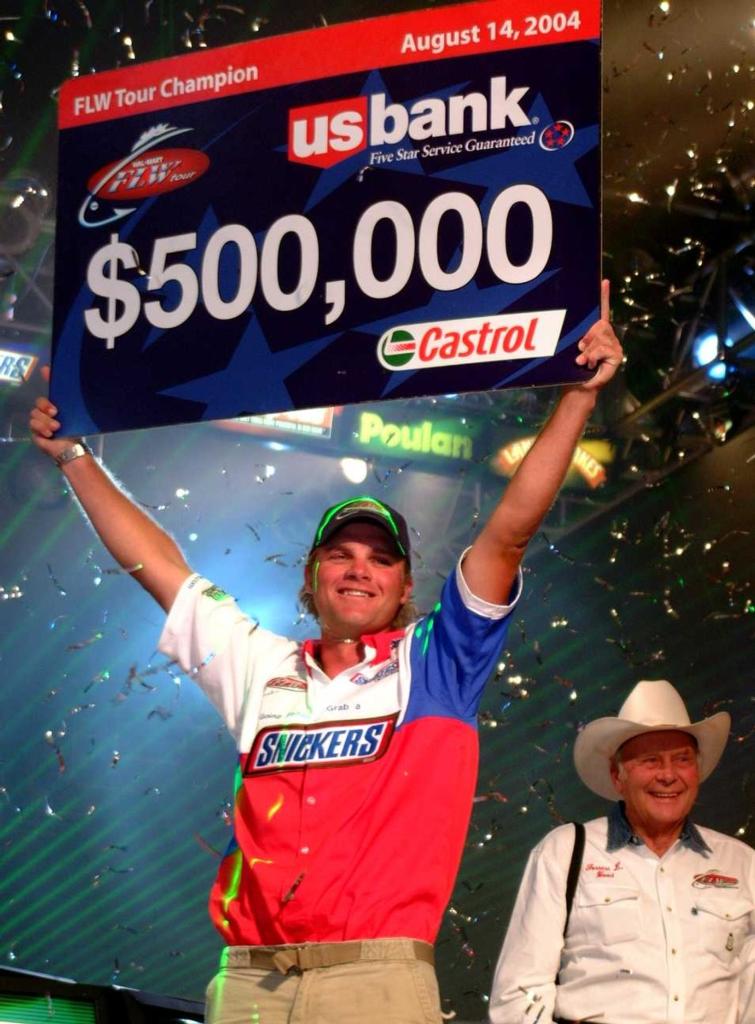
As the 2005 FLW Tour season approaches, anglers and fans alike are looking ahead to what promises to be a very eventful and exciting year. The 2005 FLW Tour schedule takes form with some of the usual venues – Lake Okeechobee, Beaver Lake and Wheeler Lake – and also revisits an old friend in Lake Toho. Two newcomers join the FLW Tour schedule as the Ouachita River and the Potomac River mark the third and sixth events of the tour. To finish off the season, the top 48 anglers in the year-end standings will visit Lake Hamilton in Hot Springs, Ark. – the host of the 2005 FLW Tour Championship.
However, while many story lines have yet to be written heading into the new season, one thing is certain: FLW Outdoors will celebrate its 10th anniversary season in grand style, awarding the world’s top anglers a record $7.6 million over the course of seven events.
Tour stop No. 1, Jan. 19-22
Nothing ordinary about Okeechobee
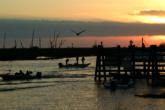 As a result of the barrage of hurricane activity that slammed into Florida’s shores this past year, there have been some conflicting accounts about the direct impact the storms have had had on the “Big O.” For example, the weekend after Hurricane Jeanne passed through Florida, it took a healthy two-day total of 37 pounds, 12 ounces to win the BFL Super Tournament at Lake Okeechobee. In addition, anglers described the unprecedented hurricane impact as a “good flushing” and argued that the storms opened up new water by ripping away vegetation that had choked the lake for many years. However, it is also clear that the effect of losing this vegetation is a double-edged sword. Although anglers may now be able to tap into areas that usually receive very little fishing pressure, the old vegetation greatly assisted anglers by preventing water from moving on a windy day. Without the presence of vegetation, the lake is more susceptible to muddy water from the strong winds. Furthermore, the trio of hurricanes produced high water that could possibly scatter fish for the foreseeable future.
As a result of the barrage of hurricane activity that slammed into Florida’s shores this past year, there have been some conflicting accounts about the direct impact the storms have had had on the “Big O.” For example, the weekend after Hurricane Jeanne passed through Florida, it took a healthy two-day total of 37 pounds, 12 ounces to win the BFL Super Tournament at Lake Okeechobee. In addition, anglers described the unprecedented hurricane impact as a “good flushing” and argued that the storms opened up new water by ripping away vegetation that had choked the lake for many years. However, it is also clear that the effect of losing this vegetation is a double-edged sword. Although anglers may now be able to tap into areas that usually receive very little fishing pressure, the old vegetation greatly assisted anglers by preventing water from moving on a windy day. Without the presence of vegetation, the lake is more susceptible to muddy water from the strong winds. Furthermore, the trio of hurricanes produced high water that could possibly scatter fish for the foreseeable future.
Local Ocala, Fla., angler Glenn Browne finished in 11th place at last year’s event and expects the country’s second-largest freshwater lake to fish differently this season.
“There is quite a bit of dirty water in a lot of places, and the lake is really fishing small,” Browne said. “Anglers primarily will be fishing around the edge of the lake and will be packed around what little clear water can be found. I think quite a few guys will be target fishing on reeds and arrowheads. Others will be flipping plastics, sight-fishing and using spinnerbaits and lipless crankbaits. I believe the sacks will be a little bit lighter than last year. I think that 30 pounds will make the top 10.”
Despite the challenges, Okeechobee will remain one of the tour’s most consistent fisheries with nearly all of the lake’s bass in some stage of the spawn come tournament time. Anglers who are prepared for a variety of conditions and are flexible with their approach will likely have success at the tour’s first event.
Tour stop No. 2, Feb. 9-12
Atypical Toho
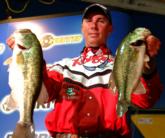 Nearly one year ago, the Florida Game and Fish Commission scraped several years of decayed vegetation and silt from the lake’s bottom. Although initial reports have been positive, the general consensus is that the benefits of scraping the lake will be seen two, three and four years down the road. Much like Okeechobee, Toho is a traditional Florida fishery that promises to fish anything but typically this February. High waters are common in Toho. And, to this point, reports indicate that the thick hydrilla weed has been unable to re-establish itself. Without consistent vegetation, the possibility of muddy water exists, all but eliminating the chances to sight-fish. Consequently, anglers who can locate the few remaining grass beds during pre-fishing should have the upper hand.
Nearly one year ago, the Florida Game and Fish Commission scraped several years of decayed vegetation and silt from the lake’s bottom. Although initial reports have been positive, the general consensus is that the benefits of scraping the lake will be seen two, three and four years down the road. Much like Okeechobee, Toho is a traditional Florida fishery that promises to fish anything but typically this February. High waters are common in Toho. And, to this point, reports indicate that the thick hydrilla weed has been unable to re-establish itself. Without consistent vegetation, the possibility of muddy water exists, all but eliminating the chances to sight-fish. Consequently, anglers who can locate the few remaining grass beds during pre-fishing should have the upper hand.
“Since the drawdown, not only did they remove the muck, but crucial vegetation and cover was removed with it,” Browne said. “Hurricane rains are still trickling through, and the dirty water has been moving through the lake the past four months, making the lake fish small. I figure most guys will end up going south. Some will fish the few remaining grass beds, targeting fish in deep cover. Others will be working the edges of channels with Rat-L-Traps and Carolina rigs. I think we’ll see more limits on Okeechobee than Toho, and 27 pounds should be enough to make the top 10.”
Tour stop No. 3, March 9-12
Running on the Ouachita
The third stop on the tour marks the season’s first visit to new water. Unlike BASS, FLW Tour anglers will have free reign to run and lock along the Ouachita River. Selected waters will not be restricted.
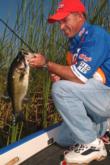 “I love fishing new water because I enjoy trying to catch fish in new places,” Kellogg’s Pro Clark Wendlandt said. “You go in there with an open mind, without any preconceived notions about where you should fish. Plus, FLW allows you to run a long ways if you want. I’ve heard that the Ouachita River fishes like a traditional Louisiana body of water. I bet a good number of people will be fishing the backwater or specifically targeting grass, logs or stumps. They’ll do this by flipping, pitching and throwing spinnerbaits.”
“I love fishing new water because I enjoy trying to catch fish in new places,” Kellogg’s Pro Clark Wendlandt said. “You go in there with an open mind, without any preconceived notions about where you should fish. Plus, FLW allows you to run a long ways if you want. I’ve heard that the Ouachita River fishes like a traditional Louisiana body of water. I bet a good number of people will be fishing the backwater or specifically targeting grass, logs or stumps. They’ll do this by flipping, pitching and throwing spinnerbaits.”
According to Paducah, Ky., native and FLW Tour veteran Dan Morehead, fishing on Ouachita will be challenging, to say the least.
“I’ve heard people compare the Ouachita to a miniature version of the Red River in Shreveport, La.,” he said. “I consider the Ouachita to be a survival tournament. If I can grind out 8 or 9 pounds a day and do enough to salvage some points, I’d be very happy. It’s a great place to fish. I just don’t expect that there are going to be huge weights. This is one tournament where extra practice will pay off due to the numerous backwater holes. Those who find fish early will catch plenty, while others who don’t get on fish will struggle to catch a limit.”
Tour stop No. 4, April 13-16
Fighting the transition on Beaver Lake
 The fourth stop on the FLW Tour schedule is a very familiar venue. However, some anglers believe that once they get on the lake, it won’t feel very familiar at all. Last season, the Wal-Mart Open on Beaver Lake was held March 31-April 3. By contrast, this season’s tournament is being held nearly two weeks later. As a general rule of thumb, Arkansas bass are active early in the spawn and get finicky as the season progresses. And, as veteran anglers know, fishing during the prespawn transition requires flexibility. Under such conditions, what works during pre-fishing might not necessarily be the winning meal ticket a few days later.
The fourth stop on the FLW Tour schedule is a very familiar venue. However, some anglers believe that once they get on the lake, it won’t feel very familiar at all. Last season, the Wal-Mart Open on Beaver Lake was held March 31-April 3. By contrast, this season’s tournament is being held nearly two weeks later. As a general rule of thumb, Arkansas bass are active early in the spawn and get finicky as the season progresses. And, as veteran anglers know, fishing during the prespawn transition requires flexibility. Under such conditions, what works during pre-fishing might not necessarily be the winning meal ticket a few days later.
Wendlandt, who has two FLW Tour victories and five top-10 finishes in six years on Beaver Lake, figures to be an early favorite – as usual.
“From what I’ve been hearing, the water is low and the fishing is good,” said Wendlandt. “If fish are still in the prespawn (mode), crankbaits, finesse worms and jighead worms will likely work best. If the fish are spawning, then sight-fishing will play a role as well. Because we’re fishing during the transition, some fish might be on beds, while others might be scattered in the backs of pockets chasing baitfish. What that means is anglers will be using a variety of techniques to catch fish. That also means a dramatic change in weather could change the fishing overnight. Beaver Lake has been improving each year. A lot depends on the weather, but it should be as good if not better than in the past.”
Tour stop No. 5, May 11-14
Launching at Wheeler
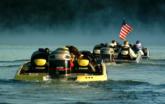 Although the fifth stop of the tour is officially listed as Wheeler Lake, it is all but certain that many anglers won’t be making any casts on Wheeler throughout the entire four-day event. While all anglers are required to launch on Wheeler Lake from Decatur, many will immediately flee to Guntersville Lake to find more fertile fishing grounds.
Although the fifth stop of the tour is officially listed as Wheeler Lake, it is all but certain that many anglers won’t be making any casts on Wheeler throughout the entire four-day event. While all anglers are required to launch on Wheeler Lake from Decatur, many will immediately flee to Guntersville Lake to find more fertile fishing grounds.
“I think nearly nine out 10 anglers will be fishing Guntersville,” Fujifilm pro Wesley Strader said. “I feel this will be a better a tournament than in years past. In previous years, we’ve fished Wheeler after the spawn has already occurred. This year we should be there when the fish are located on the beds. Take a look at the numbers from other tournaments. You will definitely see a few bags in the 20-pound range.”
With 200 boats on the water, locking is always a gamble. But from the looks of things, it may be a gamble worth taking. According to the pros, a good number of anglers will be fishing jerkbaits, crankbaits and spinnerbaits over hydrilla beds and along the ledges of creeks and channels.
Tour stop No. 6, June 22-25
Projecting the Potomac
The final stop of the regular season represents yet another visit to new water, which means that plenty of anglers will be putting in extra pre-fishing time. The Potomac is a tidal river system that offers anglers lots of water from which to choose. However, by the same measure, much of that water doesn’t hold bountiful quantities of fish. As a result, Morehead believes there will be plenty of variables for anglers to contend with while fishing the Potomac.
 “Timing will be the key on the Potomac,” Morehead said. “Right now I have heard that the fishing is real good, but I’ve always fished it in the fall, so I really don’t know what to anticipate. The Potomac is a good place to have a tournament, and I expect we’ll have some good crowds.”
“Timing will be the key on the Potomac,” Morehead said. “Right now I have heard that the fishing is real good, but I’ve always fished it in the fall, so I really don’t know what to anticipate. The Potomac is a good place to have a tournament, and I expect we’ll have some good crowds.”
Strader agreed with Morehead’s assessment that conditions could get tricky real fast.
“The one concern I have is that, if we get a crosswind, it will push the salt into the main water,” he said. “Having that salt in the water can make the fish do some pretty weird stuff and stop biting altogether.”
Many anglers will be casting crankbaits, Rat-L-Traps and spinnerbaits along the numerous creeks, rock points and grass flats.
Tour stop No., July 13-16
FLW Tour Championship – Lake Hamilton
Unlike years past, the 2005 FLW Tour Championship will take place in early summer instead of the traditional late summer-early fall date. But while some pros could find the transition away from the typical fall scheduling pattern a difficult one, many anglers welcome the change.
“We used to have to wait two months or more before the championship. Now we can fish the championship while still being in tournament mode,” Morehead said.
While fishing against the top anglers in the championship is a difficult enough task, Morehead also believes that anglers will have to contend with a healthy dose of local boat traffic as well.
 “As for Hamilton itself, the lake is a very deep and clear body of water that is comparable to Minnesota’s Lake Minnetonka. The lake is hammered by about 10 a.m. with jet skis and recreational boats. But that’s hardly anything to complain about, considering we’ll be fishing for (a first-place prize of) $500,000.”
“As for Hamilton itself, the lake is a very deep and clear body of water that is comparable to Minnesota’s Lake Minnetonka. The lake is hammered by about 10 a.m. with jet skis and recreational boats. But that’s hardly anything to complain about, considering we’ll be fishing for (a first-place prize of) $500,000.”
Those who do well on Lake Hamilton should find success early in the day. Some anglers will likely employ finesse worms in and around docks – the method that helped Luke Clausen capture last year’s championship title – while others will concentrate on deep brush piles and milfoil lines. Due to the difficulty of netting big stringers on Lake Hamilton, Morehead expects 12 pounds a day will be enough to capture a title.
Wendlandt, for his part, did little to dispute Morehead’s assessment, agreeing that Lake Hamilton should provide a difficult and challenging fishing environment.
“For me, Lake Hamilton is a tough place to fish,” he said. “Bringing in 10 pounds is a really good day there. If you average 10 pounds a day you will definitely be in the hunt. I expect most people will be fishing deep structure using crankbaits and Carolina rigs.”
But as the anglers are fully aware, a slip-up at the first event at Lake Okeechobee – or any other regular-season event for that matter – is enough to derail any dream of fishing in the 2005 FLW Tour Championship. It will be a long season, to be sure. And, in the end, some lucky angler will walk away with a cool $500,000. That much is certain. As for the rest of story, the script for the 2005 season has yet to be written.
Let the battle commence.